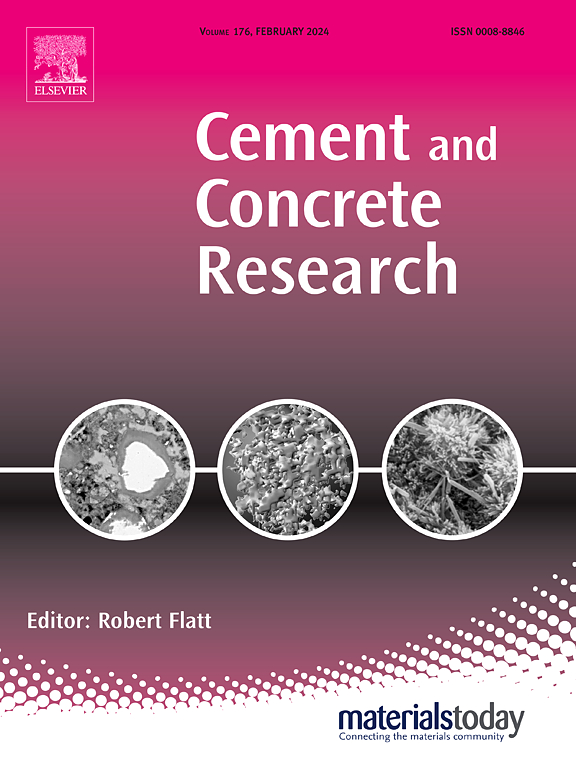Inhibition mechanism of MgO on ettringite formation in GGBS binder with inherent, internal, and external sulphates
IF 13.1
1区 工程技术
Q1 CONSTRUCTION & BUILDING TECHNOLOGY
引用次数: 0
Abstract
Excessive ettringite formation degrades cementitious binders. Ground granulated blastfurnace slag (GGBS) can alleviate the damage, but ettringite development remains inevitable in sulphate-rich environments. This study explores MgO to suppress ettringite formation in GGBS. Ettringite content, evolution, and characteristics were evaluated in MgO-GGBS with inherent, internal, and external sulphates, and compared to GGBS and CaO-GGBS. To simulate internal sulphate, 1 %–5 % Na2SO4 was introduced before hydration; for external sulphate, hardened specimens were immersed in 5 % Na2SO4 solution. With inherent sulphate, GGBS formed ettringite within 0.5 h; CaO-GGBS gradually converted ettringite to monosulfate, whereas MgO-GGBS inhibited ettringite by 60 %–80 %. 1 %–5 % internal sulphate increased ettringite in CaO-GGBS since monosulfate was transitioned to ettringite, whereas MgO-GGBS showed 45 %–85 % less ettringite. Under external sulphate, MgO-GGBS produced 62 %–72 % less ettringite. This was attributed to Al-immobilizing phases and low Mg(OH)2 solubility; hydrotalcite in MgO-GGBS intercalated sulphate. This study indicates MgO-GGBS as promising binders for sulphate-rich environments.
MgO对GGBS粘结剂中钙矾石形成的抑制机理及其内在、内在和外在硫酸盐
过量钙矾石的形成会降低胶凝粘合剂的质量。磨粒化的高炉渣(GGBS)可以减轻其危害,但在富硫酸盐环境中,钙矾石的发育是不可避免的。本研究探讨了MgO在GGBS中抑制钙矾石形成的作用。评价了MgO-GGBS中钙矾石的含量、演化和特征,并与GGBS和CaO-GGBS进行了比较。为了模拟内部硫酸盐,水化前加入1% - 5% Na2SO4;对于外部硫酸盐,硬化试样浸泡在5% Na2SO4溶液中。GGBS含固有硫酸盐,0.5 h内形成钙矾石;CaO-GGBS逐渐将钙矾石转化为单硫酸盐,而MgO-GGBS对钙矾石的抑制作用为60% - 80%。在CaO-GGBS中,由于单硫酸盐向钙矾石转变,1% - 5%的内硫酸盐增加了钙矾石,而镁- ggbs中钙矾石的含量减少了45% - 85%。在外部硫酸盐作用下,MgO-GGBS的钙矾石产量减少62% - 72%。这主要是由于al固定相和较低的Mg(OH)2溶解度;MgO-GGBS插层硫酸盐中的水滑石。该研究表明MgO-GGBS是一种很有前途的硫酸盐富环境粘合剂。
本文章由计算机程序翻译,如有差异,请以英文原文为准。
求助全文
约1分钟内获得全文
求助全文
来源期刊

Cement and Concrete Research
工程技术-材料科学:综合
CiteScore
20.90
自引率
12.30%
发文量
318
审稿时长
53 days
期刊介绍:
Cement and Concrete Research is dedicated to publishing top-notch research on the materials science and engineering of cement, cement composites, mortars, concrete, and related materials incorporating cement or other mineral binders. The journal prioritizes reporting significant findings in research on the properties and performance of cementitious materials. It also covers novel experimental techniques, the latest analytical and modeling methods, examination and diagnosis of actual cement and concrete structures, and the exploration of potential improvements in materials.
 求助内容:
求助内容: 应助结果提醒方式:
应助结果提醒方式:


